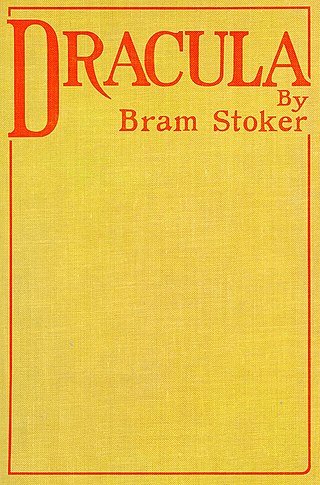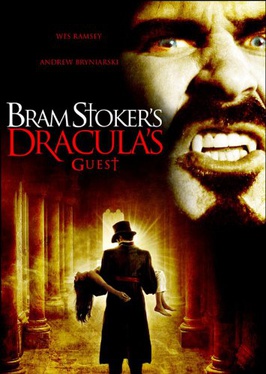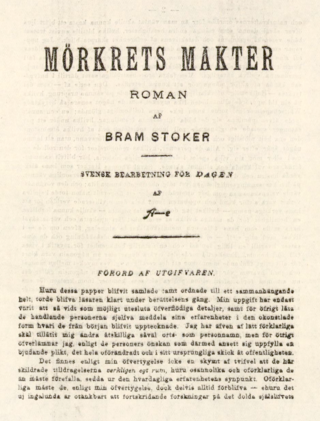Related Research Articles

Abraham Stoker was an Irish author who wrote the 1897 Gothic horror novel Dracula. During his lifetime, he was better known as the personal assistant of actor Sir Henry Irving and business manager of the West End's Lyceum Theatre, which Irving owned.

Dracula is a novel by Bram Stoker, published in 1897. An epistolary novel, the narrative is related through letters, diary entries, and newspaper articles. It has no single protagonist and opens with solicitor Jonathan Harker taking a business trip to stay at the castle of a Transylvanian nobleman, Count Dracula. Harker escapes the castle after discovering that Dracula is a vampire, and the Count moves to England and plagues the seaside town of Whitby. A small group, led by Abraham Van Helsing, investigate, hunt and kill Dracula.

Gothic fiction, sometimes called Gothic horror, is a loose literary aesthetic of fear and haunting. The name refers to Gothic architecture of the European Middle Ages, which was characteristic of the settings of early Gothic novels.

Horror is a genre of fiction that is intended to disturb, frighten or scare. Horror is often divided into the sub-genres of psychological horror and supernatural horror, which are in the realm of speculative fiction. Literary historian J. A. Cuddon, in 1984, defined the horror story as "a piece of fiction in prose of variable length... which shocks, or even frightens the reader, or perhaps induces a feeling of repulsion or loathing". Horror intends to create an eerie and frightening atmosphere for the reader. Often the central menace of a work of horror fiction can be interpreted as a metaphor for larger fears of a society.

Sir Henry Irving, christened John Henry Brodribb, sometimes known as J. H. Irving, was an English stage actor in the Victorian era, known as an actor-manager because he took complete responsibility for season after season at the West End's Lyceum Theatre, establishing himself and his company as representative of English classical theatre. In 1895 he became the first actor to be awarded a knighthood, indicating full acceptance into the higher circles of British society.

The Jewel of Seven Stars is a horror novel by Irish writer Bram Stoker, first published by Heinemann in 1903. The story is a first-person narrative of a young man pulled into an archaeologist's plot to revive Queen Tera, an ancient Egyptian mummy. It explores common fin de siècle themes such as imperialism, the rise of the New Woman and feminism, and societal progress.

Erotic horror, alternately called horror erotica or dark erotica, is a term applied to works of fiction in which sensual or sexual imagery are blended with horrific overtones or story elements for the sake of sexual titillation. Horror fiction of this type is most common in literature and film. Erotic horror films are a cornerstone of Spanish and French horror.

LGBT themes in horror fiction refers to sexuality in horror fiction that can often focus on LGBTQ+ characters and themes within various forms of media. It may deal with characters who are coded as or who are openly LGBTQ+, or it may deal with themes or plots that are specific to gender and sexual minorities.
The copyright performance of a play was a first public performance in the United Kingdom, staged purely for the purpose of securing the author's copyright over the text. There was a fear that, if a play's text was published, or a rival production staged, before its official preview or premiere, then the author's rights would be lost; to forestall these abuses, the practice arose of staging a copyright performance, which was notionally public, but in practice staged hastily before an invited audience with no publicity and no regard for the artistic quality of the acting or production. One legal authority wrote that such a performance, "though probably not necessary to fulfill any legal requirement, permits registration of first performance at Stationers' Hall and gives useful public notice to possible infringers." The practice was common in the decades after the Berne Convention of 1886; the United States was not a signatory, and plays first staged there were uncopyrightable in the United Kingdom.

Urban Gothic is a subgenre of Gothic fiction, film horror and television dealing with industrial and post-industrial urban society. It was pioneered in the mid-19th century in Britain, Ireland and the United States and developed in British novels such as Robert Louis Stevenson's Strange Case of Dr Jekyll and Mr Hyde (1886), and Irish novels such as Oscar Wilde's The Picture of Dorian Gray (1890), and Bram Stoker's Dracula (1897). In the twentieth century, urban Gothic influenced the creation of the subgenres of Southern Gothic and suburban Gothic. From the 1980s, interest in the urban Gothic revived with books like Anne Rice's Vampire Chronicles and a number of graphic novels that drew on dark city landscapes, leading to adaptations in film including Batman (1989), The Crow (1994) and From Hell (2001), as well as influencing films like Seven (1995).

The Mystery of the Sea is a mystery novel by Bram Stoker, first published in 1902. It tells the story of an Englishman living in Aberdeenshire, Scotland, who meets and falls in love with an American heiress. She is involved with the intrigues of the Spanish–American War, and a complex plot involving second sight, kidnapping, and secret codes unfolds over the course of the novel.
Carol A. Senf is professor and associate chair in the School of Literature, Media, and Communication at the Georgia Institute of Technology. With four books, two critical editions, one edited essay collection, and various critical essays, she is a recognized expert on the biography and works of Irish author Bram Stoker. She received the Lord Ruthven Award in 1999.

Bram Stoker's Dracula's Guest is a 2008 film that was written and directed by Michael Feifer. It was released direct to video in August 2008 and is loosely based on Bram Stoker's short story "Dracula's Guest".
John Edgar Browning is an American author, editor, and scholar known for his nonfiction works about the horror genre and vampires in film, literature, and culture. Previously a visiting lecturer at the Georgia Institute of Technology, he is now a professor of liberal arts at the Savannah College of Art and Design in Atlanta, Georgia.

Dr Samantha George is a Senior Lecturer in Literature in the Social Sciences, Arts & Humanities Research Institute at the University of Hertfordshire. She completed a PhD at the University of York in 2004, then taught in the Department of English Literature at Sheffield University till taking up her post at Hertfordshire in 2007. She is known for her research on eighteenth century literature and science with a particular emphasis on the role of women and botany.
A Gothic film is a film that is based on Gothic fiction or contains Gothic elements. Since various definite film genres—including science fiction, film noir, thriller, and comedy—have used Gothic elements, the Gothic film is challenging to define clearly as a genre. Gothic elements have also infused the horror film genre, contributing supernatural and nightmarish elements. To create a Gothic atmosphere, filmmakers have sought to create new camera tricks that challenge audiences' perceptions. Gothic films also reflected contemporary issues. A New Companion to The Gothic's Heidi Kaye said "strong visuals, a focus on sexuality and an emphasis on audience response" characterize Gothic films like they did the literary works. The Encyclopedia of the Gothic said the foundation of Gothic film was the combination of Gothic literature, stage melodrama, and German expressionism.
Bibliography of works on Dracula is a listing of non-fiction literary works about the book Dracula or derivative works about its titular vampire Count Dracula.

Powers of Darkness is an anonymous 1899 Swedish version of Bram Stoker’s 1897 novel Dracula, serialised in the newspaper Dagen and credited only to Bram Stoker and the still-unidentified "A—e."

The Blood of the Vampire is a Gothic novel by Florence Marryat, published in 1897. The protagonist, Harriet Brandt, is a mixed-race psychic vampire who kills unintentionally. The novel follows Harriet after she leaves a Jamaican convent for Europe, and her ill-fated attempts to integrate with Victorian society.
Bruce Wightman was a New Zealand actor and expert on Bram Stoker who co-founded the Dracula Society.
References
- ↑ Western Daily Press feature
- ↑ Hughes, William, Beyond Dracula, August 2000, Palgrave Macmillan, ISBN 978-0-333-74034-7
- ↑ Hughes, William, Empire and the Gothic: the politics of genre, Dec. 2002, Palgrave Macmillan, ISBN 978-0-333-98405-5
- ↑ Hughes, W., Smith, A.,Queering the Gothic, April 2009, Manchester University Press, ISBN 9780719078156
- ↑ Stoker, Bram, The Lady of the Shroud Jan. 2008, Tutis Digital Publishing, ISBN 978-81-8456-876-9
- 1 2 International Gothic Association
- ↑ Hughes, William, Bram Stoker: Dracula: a reader's guide to essential criticism Oct. 2008, Palgrave Macmillan, ISBN 978-1-4039-8778-5
- ↑ Bram Stoker's Dracula a reader's guide
- ↑ http://www.manchesteruniversitypress.co.uk/cgi-bin/indexer?product=9780719074837 [ dead link ]